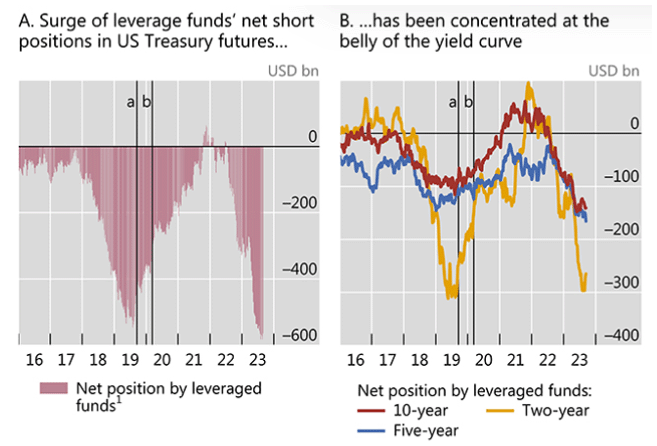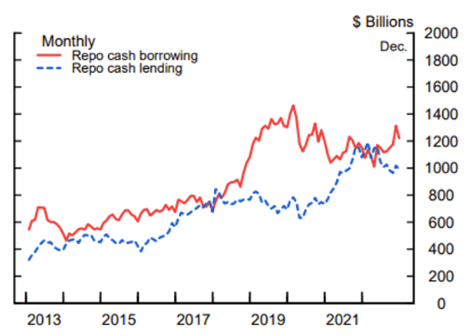
At the most recent Federal Reserve Bank of New York Treasury Market Conference, an annual check-in on risks and resilience in “the deepest and most liquid government securities market in the world,” leverage was one of the top talking points. Caution was in the air around basis trades as a source of leverage and potential systemic instability.
“I want to recognize that leveraged trading, including in the so-called basis trade, can play an important role in capital markets,” Federal Reserve Board Vice Chair for Supervision Michael Barr said at the November 2023 event. “Basis trading serves a valuable function of market efficiency, improving the connection between cash and futures pricing and facilitating access to futures for investing and risk management.
“Leverage allows market participants to arbitrage away relatively small pricing discrepancies, enhancing the integration of prices across economically equivalent instruments and markets,” Barr continued. “But leverage can also increase risks to both market participants and to Treasury market functioning and must be managed appropriately by both investors and their counterparties, including through collecting margin to manage counterparty risk.”
Barr thus presented the issue in a balanced way, as controversy over the basis trade and the need to control it was simmering.
In an arbitrage commonly practiced by hedge funds, a basis trade exploits the difference between Treasury futures and their underlying bonds. Less regulated than banks and asset managers, hedge funds “can often borrow money at cheaper rates and employ more leverage – especially when posting ultra-safe Treasury bonds as collateral – which makes those trades worthwhile for them, even for small differences in repo rates,” as explained in Who’s Afraid of the Basis Trade? by risk analytics provider Qontigo.
Information Needed
Staff studies by the Federal Reserve and other agencies, Barr remarked, “have found that hedge funds are significant investors in Treasury cash, derivatives, and repo markets; that their highly leveraged positions in Treasury markets are facilitated by very low, or even zero, haircuts on their repo financing; and that demand for this leverage is highly concentrated among a handful of large hedge funds.”
He noted that “liquidation of leveraged Treasury positions by hedge funds appears to have contributed to the Treasury market stress in March 2020,” and that more data is needed to better understand this activity. Barr saw “an important step forward” in a then pending proposal from the Treasury Department’s Office of Financial Research to collect information on non-centrally cleared bilateral repo transactions.
Under Secretary for Domestic Finance Nellie Liang
According to a Moody’s analysis, the Securities and Exchange Commission’s recently adopted rules requiring central clearing of those transactions can mitigate the liquidity risks associated with an abrupt unraveling of basis trades.
“This basis activity could provide benefits by increasing the liquidity of Treasury securities, improving integration between related cash and derivative market segments, and translating demand for futures into demand for Treasury securities,” Treasury Under Secretary for Domestic Finance Nellie Liang told the Treasury Market Conference.
“At the same time, we are attentive to the potential risks of a disorderly unwind of leveraged positions, especially those reliant on rolling over financing every day,” Liang went on. “Naturally, we are monitoring these developments closely, because of its potential financial stability risks, and also because of its potential effects on Treasury market liquidity and demand for Treasury securities.”
“Conducting Surveillance”
SEC Chair Gary Gensler referred in a November speech to “elevated” hedge fund leverage and to “jitters over time” in Treasuries and repo – in 2007, 2008 and 2019 as well as 2020.
At a December meeting of the Commodity Futures Trading Commission’s Market Risk Advisory Committee, members of its Market Structure Subcommittee said they intended to produce a report on basis trades.
“The basis trade spans multiple regulatory agencies, with none seeing the full picture and understanding the true risks,” CFTC Chairman Rostin Behnam said on November 16. “We all must remain vigilant. The CFTC is monitoring for any anomalies, conducting surveillance, and reaching out to registrants and participants for additional insight.”
Kenneth Griffin, founder and CEO of the Citadel hedge fund, has contended that basis trading lowers the cost of government debt and improves overall credit availability. Clearing could result in taxpayers losing “billions of dollars a year” of benefits attributable to the practice, he said, and there is a risk of “crowd[ing] out funding for corporate America, raising the cost of capital to build a new factory or hire more employees.”
Among those who have publicly sided with Griffin are Kenneth Bentsen, president and CEO of the Securities Industry and Financial Markets Association, who has been broadly critical of Gensler’s rulemaking agenda and priorities; and CME Group Chairman and CEO Terrence Duffy.
Systemic Perspective
Olivier d’Assier, head of applied research, APAC for Qontigo, said that regulators take a more systemic perspective based on stress tests, liquidity and contagion risks. “For this reason, they tend to be more informed than what any one individual hedge fund might see or be looking at,” he said.
Griffin, however, argued that the SEC is overly consumed with the systemic concerns.

The Bank for International Settlements Quarterly Review plots rising speculative positions in U.S. Treasury futures during the (a) September 2019 repo market stress and (b) March 2020 “dash for cash.” The left graph shows the sum of net positions in two-, five- and 10-year futures.
The Bank for International Settlements, in its September Quarterly Review, deemed “the current build-up of leveraged short positions in U.S. Treasury futures [to be] a financial vulnerability worth monitoring because of the margin spirals it could potentially trigger.
“While this channel was well recognized in the March 2020 ‘dash-for-cash’ episode,” wrote BIS senior economists Fernando Avalos and Vladyslav Sushko, “other factors garnered more attention in the context of the September 2019 repo market stress. Yet the margin deleveraging in August 2019 may have presaged the funding-market disruptions that followed a month later. Margin deleveraging, if disorderly, has the potential to dislocate core fixed-income markets.”
When the Spread Widens
Matthias Fleckenstein, associate professor of finance at the University of Delaware’s Lerner College of Business and Economics, points out that the basis-trade spread widened in 2023 as Treasury offerings were increasing to finance the national debt. This can be an attractive dynamic for hedge funds but a condition reminiscent of March 2020, when mutual funds and non-U.S. investors sold off Treasury bonds to generate cash. Fleckenstein said the shock was likely exacerbated by the Fed’s Supplementary Leverage Ratio (SLR), implemented in 2016, which required banks to hold more capital against Treasury bonds.
The SLR remains in place, makes holding Treasuries on banks’ balance sheets more costly and reduces banks’ ability to absorb Treasury selloffs, potentially intensifying market events that could depress Treasury prices and further widen the basis-trade spread. Such widening “is bad news for hedge funds, because it exposes them to mark-to-market losses” as in March 2020.
At that time, hedge funds unwound positions by selling Treasuries. That could have sparked a spiral of selling and a more serious market disruption if the Fed had not stepped in to buy Treasuries and exempted banks from the SLR, Fleckenstein said. He added that there is no assurance that the Fed would do the same in the future.
“While the general evidence points to sales of the basis by hedge funds during March,” said a July 2020 Office of Financial Research paper, “we do not find conclusive evidence that these sales in turn caused greater illiquidity in the Treasury market. While many of the risks of this trade seem to have materialized, evidence of spillovers into Treasury liquidity and short-term funding disruptions are limited. However, it is worth noting that had liquidity not returned to the Treasury market when it did, and had repo rates not fallen, the consequences for relative-value hedge funds could have been much worse.”
Possible Triggers
To optimize basis trades, volatility must remain within what d’Assier called a “workable range.” Market volatility was declining last year until the Hamas-Israel conflict in October. Volatility eased again in view of positive corporate earnings and economic indicators.
A macroeconomic, geopolitical or catastrophic event “could send market risk surging again and raise liquidity concerns linked to popularity of the basis trade,” the Qontigo expert said.

Per a September 2023 FEDS Notes (SEC Form PF data), hedge funds’ total repo borrowing roughly doubled over the two years preceding the pandemic, while their repo lending remained mostly flat. “This was consistent with the increase in hedge funds’ UST gross exposures due to the basis trade,” the report said. Consistent with the re-emergence of the cash-futures basis trade, “repo borrowing trended up during the last months of 2022.”
Federal Reserve FEDS Notes research last August noted that hedge funds’ short futures positions in two-, five- and 10-year Treasuries increased by $411 billion between October 4, 2022, and May 9, 2023, approaching the previous, July 2019 high of $750 billion. Hedge funds’ repo cash borrowing eased after reaching nearly $1.5 trillion in early 2020; at year-end 2022, it was still elevated by historical standards, at $1.2 trillion, said a subsequent FEDS Notes.
Meanwhile, Fleckenstein said, longer-term repos since 2020 have become more expensive, pushing hedge funds to rely more on overnight repos. Occasional spikes in the overnight rate have inhibited funds’ trade rollovers, forcing unwinding of the basis trade. In addition, the professor said, the recent move to the secured overnight financing rate (SOFR) benchmark, generated from overnight repo trades, means that disruptions in the repo market could spill over into other markets priced over SOFR.
“It’s an open question how this would unfold, but it’s fair to say that there’s a link from the repo market to the broader financial market,” he said.
Short of such disruptions as a government shutdown, credit downgrade or banking crisis, the basis-trade concerns could resolve themselves, d’Assier said. Avoidance of a “hard landing” could boost equities, increase the breadth and types of strategies hedge funds can employ, and “help defuse the risk from an over-crowded basis trade as other investment opportunities arise.”
Investors who believe basis trades pose significant risk should ensure their strategies are not all linked to the same investment horizon, mixing short-, medium-, and longer-term trades, d’Assier advised. “Stress testing to model risk events on a portfolio is particularly beneficial and enables investors to be prepared with a list of hedging trades in case reality turns out differently than the models suggested,” he said.
Topics: Financial Markets